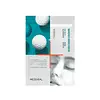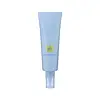Mediheal Madecassoside UV Cut Outdoor Sun Patch Versus Laneige Water Bank UV Barrier Sunscreen SPF 50+
What's inside
What's inside
 Key Ingredients
Key Ingredients

 Benefits
Benefits

 Concerns
Concerns

 Ingredients Side-by-side
Ingredients Side-by-side

Water
Skin ConditioningGlycerin
HumectantSodium Polyacrylate
AbsorbentDipropylene Glycol
HumectantPolyacrylic Acid
Emulsion StabilisingNiacinamide
SmoothingAgar
MaskingHydroxyethyl Urea
HumectantHydroxyacetophenone
AntioxidantXanthan Gum
EmulsifyingCaprylyl Glycol
EmollientCellulose Gum
Emulsion StabilisingAluminum Glycinate
AstringentCetyl Ethylhexanoate
EmollientTartaric Acid
BufferingPentasodium Triphosphate
BufferingCaprylyl/Capryl Glucoside
CleansingAdenosine
Skin ConditioningDipotassium Glycyrrhizate
HumectantSodium Ascorbyl Phosphate
AntioxidantGlutathione
Madecassoside
Antioxidant1,2-Hexanediol
Skin ConditioningCentella Asiatica Leaf Extract
Skin ConditioningSodium Hyaluronate
HumectantCentella Asiatica Extract
CleansingPotassium Hyaluronate
Skin ConditioningSodium Hyaluronate Crosspolymer
HumectantHydrolyzed Sodium Hyaluronate
Skin ConditioningHyaluronic Acid
HumectantSodium Acetylated Hyaluronate
HumectantAsiaticoside
AntioxidantAsiatic Acid
Skin ConditioningMadecassic Acid
Skin ConditioningWater, Glycerin, Sodium Polyacrylate, Dipropylene Glycol, Polyacrylic Acid, Niacinamide, Agar, Hydroxyethyl Urea, Hydroxyacetophenone, Xanthan Gum, Caprylyl Glycol, Cellulose Gum, Aluminum Glycinate, Cetyl Ethylhexanoate, Tartaric Acid, Pentasodium Triphosphate, Caprylyl/Capryl Glucoside, Adenosine, Dipotassium Glycyrrhizate, Sodium Ascorbyl Phosphate, Glutathione, Madecassoside, 1,2-Hexanediol, Centella Asiatica Leaf Extract, Sodium Hyaluronate, Centella Asiatica Extract, Potassium Hyaluronate, Sodium Hyaluronate Crosspolymer, Hydrolyzed Sodium Hyaluronate, Hyaluronic Acid, Sodium Acetylated Hyaluronate, Asiaticoside, Asiatic Acid, Madecassic Acid
Water
Skin ConditioningDiethylhexyl Succinate
EmollientPropanediol
SolventDrometrizole Trisiloxane
UV AbsorberEthylhexyl Triazone
UV AbsorberDiethylamino Hydroxybenzoyl Hexyl Benzoate
UV FilterTerephthalylidene Dicamphor Sulfonic Acid
UV Absorber1,2-Hexanediol
Skin ConditioningBehenyl Alcohol
EmollientMethyl Trimethicone
Skin ConditioningTromethamine
BufferingSodium Polyacryloyldimethyl Taurate
Emulsion StabilisingButylene Glycol
HumectantPolyacrylate Crosspolymer-6
Emulsion StabilisingC20-24 Alkyl Dimethicone
Skin ConditioningArachidyl Alcohol
EmollientCaprylyl Glycol
EmollientSodium Methyl Stearoyl Taurate
CleansingEthylhexylglycerin
Skin ConditioningArachidyl Glucoside
EmulsifyingParfum
MaskingAllantoin
Skin ConditioningHydrolyzed Hyaluronic Acid
HumectantSodium Metaphosphate
BufferingBisabolol
MaskingRubus Fruticosus Fruit Extract
AstringentFragaria Vesca Leaf Extract
AstringentTocopherol
AntioxidantSodium Hyaluronate
HumectantSodium Hyaluronate Crosspolymer
HumectantHyaluronic Acid
HumectantSodium Acetylated Hyaluronate
HumectantWater, Diethylhexyl Succinate, Propanediol, Drometrizole Trisiloxane, Ethylhexyl Triazone, Diethylamino Hydroxybenzoyl Hexyl Benzoate, Terephthalylidene Dicamphor Sulfonic Acid, 1,2-Hexanediol, Behenyl Alcohol, Methyl Trimethicone, Tromethamine, Sodium Polyacryloyldimethyl Taurate, Butylene Glycol, Polyacrylate Crosspolymer-6, C20-24 Alkyl Dimethicone, Arachidyl Alcohol, Caprylyl Glycol, Sodium Methyl Stearoyl Taurate, Ethylhexylglycerin, Arachidyl Glucoside, Parfum, Allantoin, Hydrolyzed Hyaluronic Acid, Sodium Metaphosphate, Bisabolol, Rubus Fruticosus Fruit Extract, Fragaria Vesca Leaf Extract, Tocopherol, Sodium Hyaluronate, Sodium Hyaluronate Crosspolymer, Hyaluronic Acid, Sodium Acetylated Hyaluronate
Ingredients Explained
These ingredients are found in both products.
Ingredients higher up in an ingredient list are typically present in a larger amount.
1,2-Hexanediol is a synthetic liquid and another multi-functional powerhouse.
It is a:
- Humectant, drawing moisture into the skin
- Emollient, helping to soften skin
- Solvent, dispersing and stabilizing formulas
- Preservative booster, enhancing the antimicrobial activity of other preservatives
Caprylyl Glycol is a humectant and emollient, meaning it attracts and preserves moisture.
It is a common ingredient in many products, especially those designed to hydrate skin. The primary benefits are retaining moisture, skin softening, and promoting a healthy skin barrier.
Though Caprylyl Glycol is an alcohol derived from fatty acids, it is not the kind that can dry out skin.
This ingredient is also used as a preservative to extend the life of products. It has slight antimicrobial properties.
Learn more about Caprylyl GlycolHyaluronic acid is naturally found in healthy skin. It is a humectant, meaning it draws moisture to your skin.
This ingredient helps hydrate, soothe, and protect the skin.
What makes hyaluronic acid so hydrating? It has the capacity to bind or hold large amounts of water.
Fun fact: It is already naturally found in our bodies, such as the fluids of our eyes and our joints.
Studies find this ingredient to have anti-inflammatory and anti-microbial properties. This can help speed up wound-healing.
Hyaluronic acid can be irritating if the molecule has a low-molecular weight, or if the molecules are small.
One study found low-molecular weight hyaluronic acid to be pro-inflammatory, meaning some people may experience irritation. This is because our bodies use hyaluronic acid in the wound-healing process to signal to our bodies, via irritation, that something needs healing.
The same study found high-molecular weight hyaluronic acid to be anti-inflammatory.
These are some other common types of Hyaluronic Acid:
Learn more about Hyaluronic AcidSodium Acetylated Hyaluronate is a type of Hyaluronic Acid.
Hyaluronic Acids help moisturize, soothe, and protect the skin.
Read about common types of Hyaluronic Acid here:
Sodium Hyaluronate
Hydrolyzed Hyaluronic Acid
Hyaluronic Acid
Sodium Hyaluronate is hyaluronic acid's salt form. It is commonly derived from the sodium salt of hyaluronic acid.
Like hyaluronic acid, it is great at holding water and acts as a humectant. This makes it a great skin hydrating ingredient.
Sodium Hyaluronate is naturally occurring in our bodies and is mostly found in eye fluid and joints.
These are some other common types of Hyaluronic Acid:
Learn more about Sodium HyaluronateSodium Hyaluronate Crosspolymer is a type of hyaluronic acid. In fact, it is modified version of hyaluronic acid.
The structure of Sodium Hyaluronate Crosspolymer allows it to stay in the skin's top layer for a longer period of time. This allows for even more hydration and humectant action than hyaluronic acid.
These are some other common types of Hyaluronic Acid:
Learn more about Sodium Hyaluronate CrosspolymerWater. It's the most common cosmetic ingredient of all. You'll usually see it at the top of ingredient lists, meaning that it makes up the largest part of the product.
So why is it so popular? Water most often acts as a solvent - this means that it helps dissolve other ingredients into the formulation.
You'll also recognize water as that liquid we all need to stay alive. If you see this, drink a glass of water. Stay hydrated!
Learn more about Water